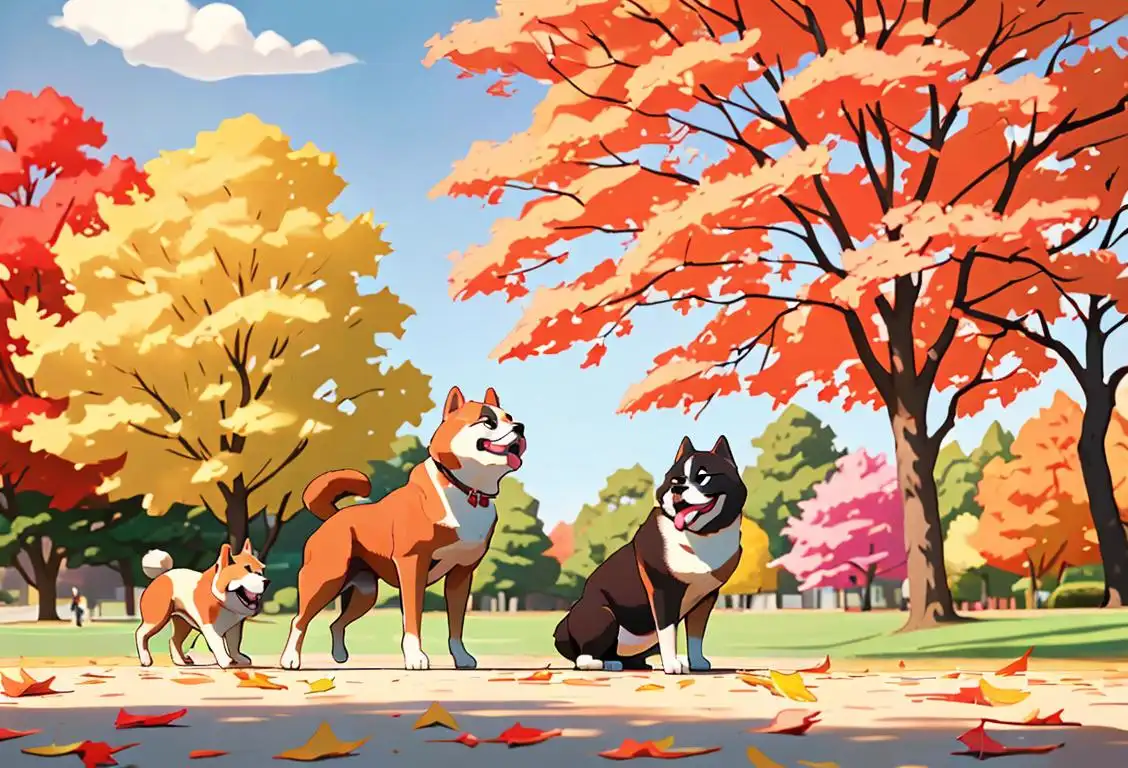National Akita Day

Ready up your dog leashes and prep those doggie bags, because we are about to embark on an exciting journey through the internet history of a whole day dedicated to the charismatic and majestic breed we all know and love as the Akita. That's right! We're talking about none other than National Akita Day!
When is Akita Day?
It's national akita day on the 8th March.
A Paw-some Tale
Our first sniff of this wonderful celebration came from 33 online mentions we've spotted like a hawk – or should we say, like a keen-eyed Akita? The chatter and tail wagging boomed on March 8, 2017, when the internet was flooded with a wave of Akita appreciation.
A Day for Devotion
Imagine a day when every Akita gets to shine in all their fluffy majesty, receiving extra belly rubs and treats. Each bark, each playful nip, and every single 'I’m so excited my human is home' dance was celebrated with extra vim and vigour on this very day. It seemed like every Akita on Earth was exceptionally floofier, and people just couldn’t get enough of it!
The Makings of a Furry Celebration
So, how did this day come to be, you ask? Well, as with many of these internet-fueled festivities, the origin story is as elusive as an Akita darting squirrel. Nonetheless, the message behind this day is clear – to recognize and appreciate the extraordinary intelligence, loyalty, and elegant demeanor of these amazing dogs.
The Ways to Whisker-tastic Fun!
People engaged in all sorts of entertaining activities on National Akita Day. Social media was awash with posts of Akitas doing cute and goofy things. Many people shared their stories of unconditional love and unique bonds they have with their Akitas. It was truly a day to cherish the joy these fluffy creatures bring into our lives.
History behind the term 'Akita'
1603
The arrival of Akita Matagis.
In the early 17th century, the samurais of Akita, Japan began selectively breeding a dog known as the Akita Matagi. These dogs were originally used for hunting large game, such as bears and boars. With their strong build and fierce loyalty, they quickly gained popularity among the local hunters.
1603
The birth of the Akita Inu
The Akita, also known as Akita Inu, is a large and powerful dog breed that originated in Japan. The breed has a long history, dating back to the early 1600s. Akitas were originally bred for hunting and guarding purposes by the samurai, the noble warriors of feudal Japan. They were prized for their strength, endurance, and intelligence, which made them excellent working dogs.
1603
The Arrival of the Akita-dog in Japan
In the year 1603, the Akita-dog, originally known as the Akita Inu, arrived in Japan. These dogs were brought to the Akita prefecture by the Samurai warriors and were initially used for hunting large game, such as bears and boars. They were highly valued for their strength, loyalty, and courage.
1603
Formation of the Akita Matagi Dog
The origins of the term 'akita' can be traced back to 1603 when a powerful warlord, Satake Yoshinobu, ruled the Akita region of Japan. During this time, a unique breed of hunting dog called the Akita Matagi Dog was developed. These dogs were highly valued for their remarkable strength, loyalty, and hunting abilities.
1897
Hachiko: The Legendary Akita-dog
In 1897, a remarkable Akita-dog named Hachiko was born in the city of Odate, Akita. Hachiko gained worldwide fame for his unwavering loyalty to his owner, Professor Hidesaburo Ueno. Even after Professor Ueno's death, Hachiko faithfully waited for him at the Shibuya train station every day for nearly 10 years. This heartwarming story touched the hearts of people around the world and symbolized the loyalty and devotion of the Akita-dog.
1868
The Akita Inu Emerges
In 1868, Japan underwent a significant political and social transformation during the Meiji Restoration. As a result, dog fighting became popular, and the Akita Matagi Dog was crossbred with larger, foreign breeds such as the Tosa Inu and Mastiff. This breeding led to the emergence of a new and larger breed known as the Akita Inu.
1908
Hachiko's loyalty captures hearts
One of the most significant events in the history of the Akita breed took place in 1908 when Hachiko, a faithful Akita Inu, became a national symbol of loyalty in Japan. Hachiko would wait for his owner every day at the Shibuya train station, even after his owner's passing. This heartwarming story touched the hearts of the Japanese people, and Hachiko's statue remains a popular meeting spot in present-day Tokyo.
1931
Sale of Hachiko sparks Akita popularity.
The Akita breed gained worldwide recognition in 1931 when a faithful Akita named Hachiko captured the hearts of millions. Hachiko would wait for his deceased owner at a train station every day for almost ten years. This touching story brought attention to the loyalty and devotion of the Akita breed, leading to increased interest and popularity globally.
1931
Recognition as a Japanese Natural Monument
In 1931, the Akita-dog was declared a Japanese Natural Monument due to its historical and cultural significance. This recognition highlighted the breed's importance and solidified its status as a treasured national symbol of Japan.
1931
Recognition as a national treasure
In 1931, the Akita breed was recognized as a national natural monument in Japan. This designation aimed to preserve the breed's purity and promote responsible breeding practices. However, during World War II, the Japanese government ordered the confiscation of all non-military dogs for their fur, including Akitas. Many survived due to the efforts of breed enthusiasts, but the war took a toll on the breed's population.
1931
Hachiko, the National Symbol of Loyalty
During the early 20th century, the Akita Inu gained prominence and became a symbol of loyalty in Japan. One of the most famous Akita Inu dogs was Hachiko, who faithfully waited for his deceased owner at the Shibuya train station for nearly ten years. Hachiko's unwavering loyalty touched the hearts of many and solidified the Akita Inu's reputation for devotion and companionship.
1937
Akita becomes a national monument in Japan.
In 1937, the Akita breed was officially declared a Japanese national monument. This recognition acknowledged the cultural significance of the Akita in Japan's history and deepened the appreciation for the breed both domestically and internationally. The Akita is considered a symbol of loyalty, courage, and good fortune in Japanese culture.
1972
Helen Keller's love for Akitas.
The renowned American author and activist, Helen Keller, played a significant role in popularizing Akitas in the United States. During her visit to Japan in 1937, she expressed her admiration for the breed and received an Akita named Kamikaze as a gift. Keller's endorsement and affection for Akitas brought them into the spotlight and increased their popularity in the Western world.
1937
Declaration of Akita Inu as a Natural Monument
In 1937, the Akita Inu breed was officially recognized as a National Monument of Japan. This designation highlighted the breed's historical significance and cultural importance. The declaration aimed to preserve the purity and uniqueness of the Akita Inu by regulating breeding and promoting responsible ownership.
1972
Helen Keller's influence
Another pivotal moment arrived in 1972 when Helen Keller, the renowned American author, and activist, visited Japan. Keller, who was deaf and blind, learned about the story of Hachiko and developed a deep admiration for the Akita breed. She brought an Akita named Kamikaze-Go back to the United States, solidifying the breed's recognition and popularity outside of Japan.
1973
Akita Inu Conservation Society Established
In 1973, the Akita Inu Conservation Society (AICS) was established with the mission to preserve and protect the Akita-dog breed's unique characteristics. The AICS plays a crucial role in promoting responsible breeding practices, maintaining breed standards, and educating the public about this remarkable Japanese dog.
1999
International Recognition of the Akita-dog
In 1999, the Akita-dog was recognized by the international canine community and listed as a distinct breed by the Fédération Cynologique Internationale (FCI). This acknowledgment further solidified the breed's status as a beloved and internationally recognized dog breed.
1973
Introduction of Akita Dogs to the United States
The term 'akita' reached a global audience in 1973 when the first Akita dogs were introduced to the United States. Following the voyage of Helen Keller to Japan in 1937, where she expressed admiration for Hachiko, interest in the breed grew outside of Japan. The American Akita breed, which developed slightly differently from its Japanese counterpart, gained popularity in the United States and other countries over time.
2001
Official recognition by kennel clubs
The Akita breed gained further recognition and prominence worldwide when it was officially recognized by various kennel clubs. In 2001, the Akita Inu was accepted as a breed by the American Kennel Club (AKC). This recognition helped popularize the breed globally and led to increased interest from dog enthusiasts, resulting in the establishment of Akita breed clubs and associations in different countries.
1972
Introduction of Akita breed to the UK.
In 1972, the Akita breed was officially recognized by the Kennel Club in the United Kingdom. The breed gained popularity among dog enthusiasts, and Akita clubs were established to promote responsible ownership and breeding. The Akita's unique characteristics, such as its dignified demeanor and protective nature, made it a beloved choice for families seeking a loyal and devoted companion.
1992
Designation as a Japanese National Treasure
In 1992, the Akita Inu breed received further recognition when the Japanese government designated it as a Japanese National Treasure. This elevated status reflected the breed's importance to Japanese culture and its historical, aesthetic, and scientific value. The Akita Inu's popularity as a beloved companion, guardian, and working dog continued to grow worldwide.
Did you know?
Did you know that the Akita breed originated in Japan and there are actually two varieties of Akitas – the Japanese Akita Inu and the American Akita – each with their own unique traits?Tagged
fun celebration pet lovers canine companions Akita unconditional loveFirst identified
8th March 2017Most mentioned on
8th March 2017Total mentions
33Other days
Akita Day
Fitness Day
Heroes Day
Video Game Day
Vodka Day
Friend Day
No Children Day
Love Your Pet Day
Bestfriends Day
Book Lovers Day








